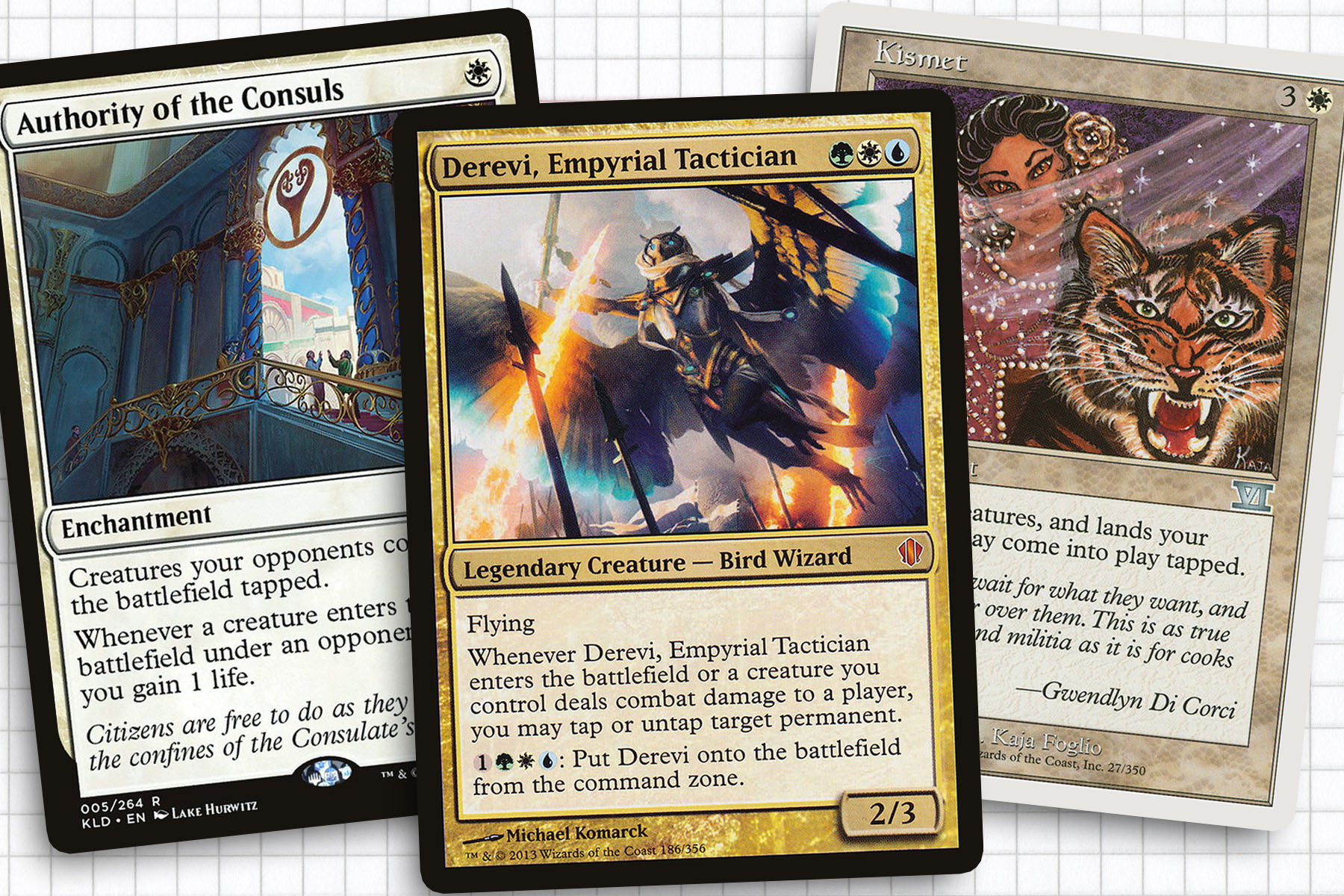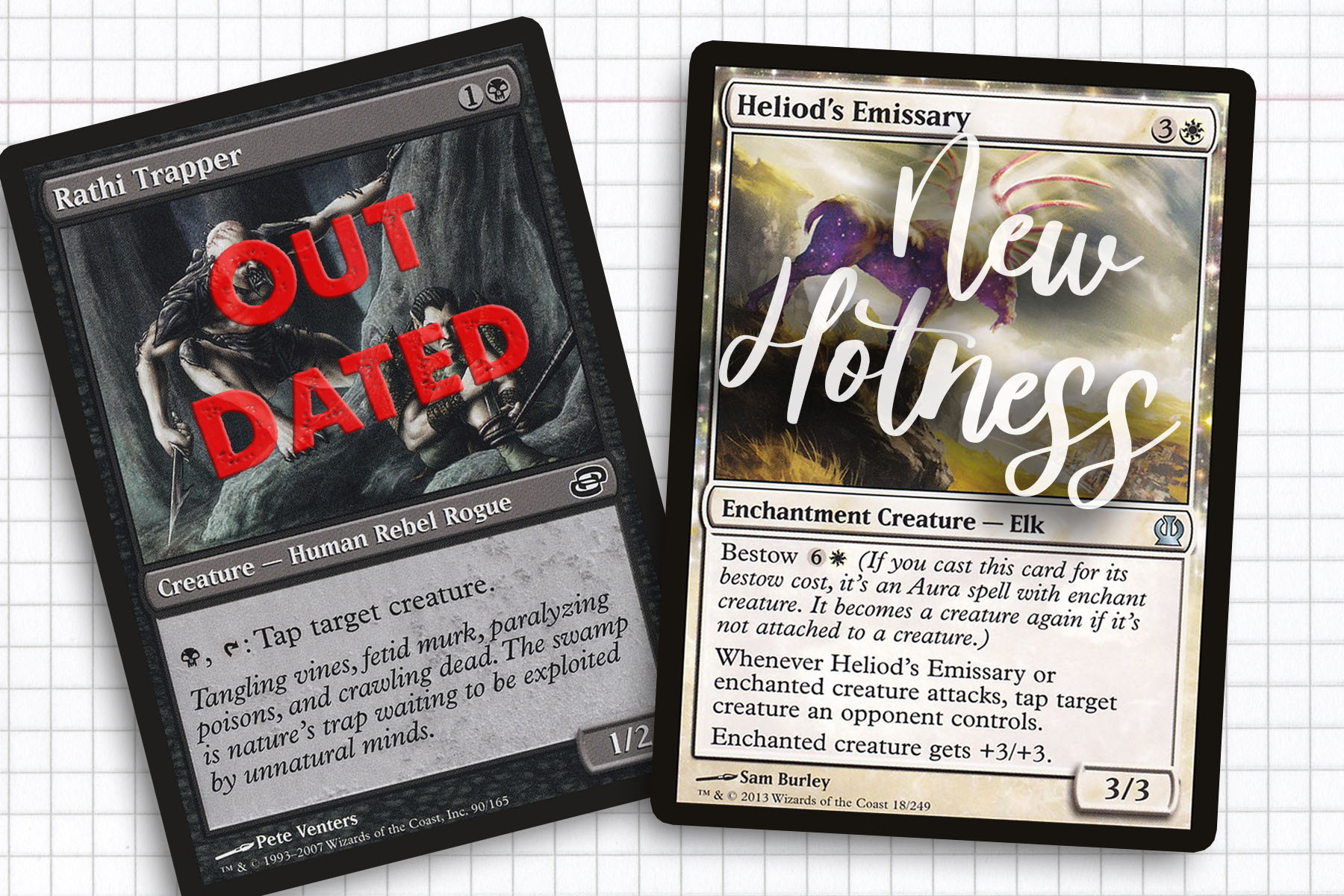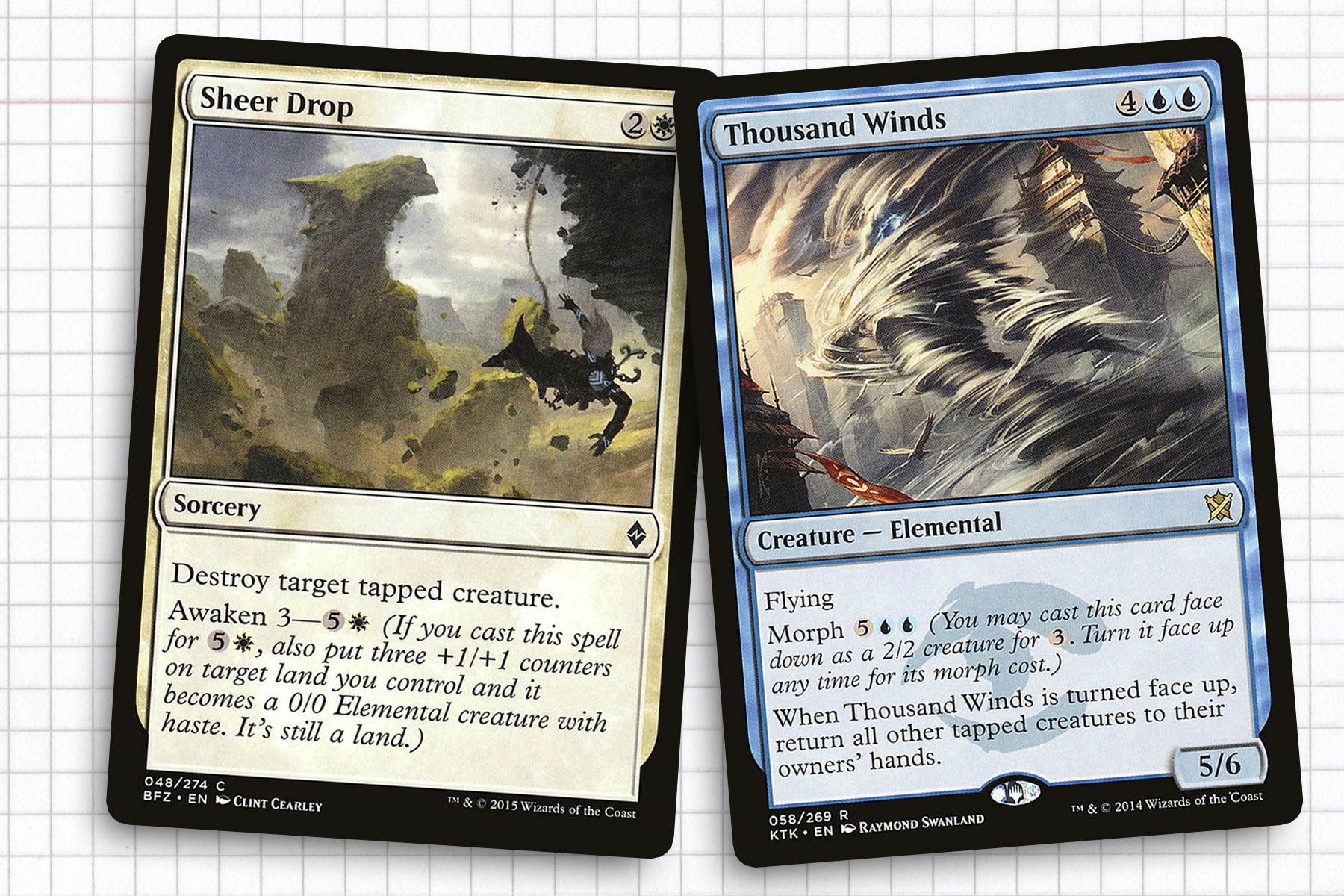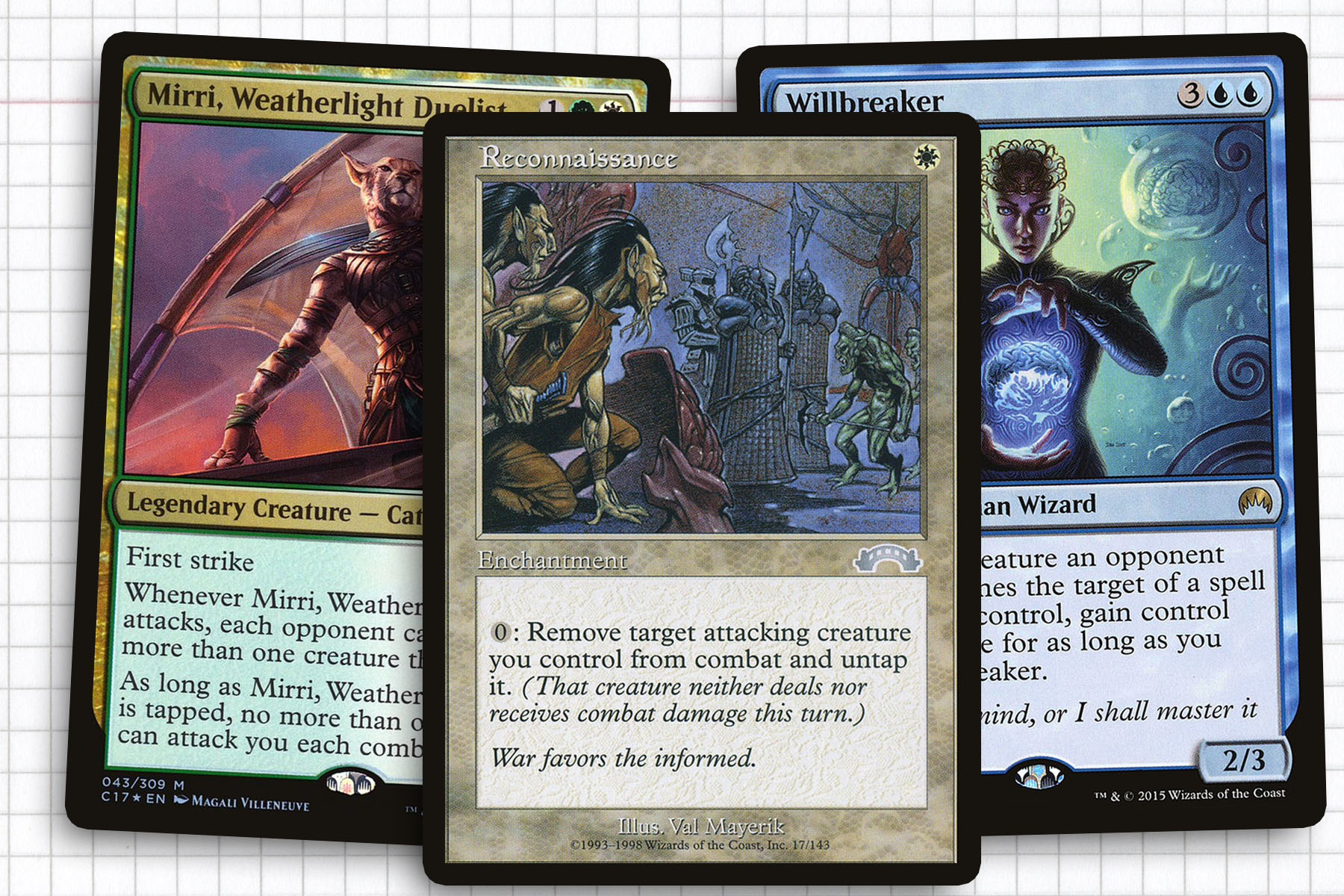My inspiration this week comes from a casual deck that I developed and played with my local playgroup over a decade ago. From 2009 to 2014, I was playing casual Magic pretty much every weekend. In the middle of all of that I was spending my time between gaming sessions taking in the pieces to form this strange mismash of an Orzhov deck I would (of course) jokingly call “I’d Tap That”—based around the interactions between Master Decoy and Royal Assassin.
The “tap down” archetype is something that I turned into a Sorin Oathbreaker deck last year, but it’s one I’ve struggled to crack for the better part of three years in Commander. Today, I think I have finally found the right way to address some of the perceived shortcomings as well as my own biases. The funniest part to me is that evolution was already rearing its head years ago and I just was too stubborn to innovate. Let’s look at the deck and then talk about the journey I had to go on to find its cohesive identity.
One of the biggest hurdles to finding the identity of this deck was allowing myself to remove Black from the equation. I had become so married to that concept, the idea of building around Derevi felt out of the question—I was forcing the deck to be helmed by Atraxa, Praetors’ Voice. But in hindsight Derevi is the logical option to manipulate tapping and give the deck a cohesive identity. Once I allowed myself to build in that direction, everything became more fluid. I began to see the soul of the deck and started to realize the mistakes I had made trying to transfer my ideas between two very different formats.
Commander: Derevi, Empyrial Tactician
Creatures: Ardenvale Tactician, Bounding Krasis, Breaching Leviathan, Deadeye Harpooner, Dungeon Geists, Gustcloak Cavalier, Heliod’s Emissary, Icefall Regent, Imposing Sovereign, Kapsho Kitefins, Kor Hookmaster, Lorthos, the Tidemaker, Masako the Humorless, Mirri, Weatherlight Duelist, Ojutai, Soul of Winter, Somnophore, Spellweaver Duo, Subjugator Angel, Sunblast Angel, Thousand Winds, Tidal Force, Willbreaker
Planeswalkers: Dovin Baan, Gideon Jura, Jace, Ingenious Mind-Mage, Tamiyo, Field Researcher, Tamiyo, the Moon Sage, Teferi, Temporal Archmage
Instant: Beast Within, Cryptic Command, Ensnare, Expose Evil, Feeling of Dread, Galestrike, Generous Gift, Icy Blast, Thoughtweft Gambit
Sorceries: Cultivate, Kodama’s Reach, Rampant Growth, Righteous Fury, Rite of Replication, Sheer Drop, Stolen Identity, Swift Reckoning, Take Vengeance, Treasure Cruise
Artifacts: Azorius Locket, Azorius Signet, Bident of Thassa, Darksteel Ingot, Simic Signet, Vedalken Orrery
Enchantments: Authority of the Consuls, Blind Obedience, Citadel Siege, Curse of Inertia, Frozen Aether, Kismet, Leyline of Anticipation, Quiet Contemplation, Reconnaissance, Seal Away
Lands: 2 Forest, 6 Island, 3 Plains, Arcane Lighthouse, Ash Barrens, Azorius Chancery, Blossoming Sands, Bountiful Promenade, Breeding Pool, City of Brass, Command Tower, Evolving Wilds, Exotic Orchard, Halimar Depths, Hallowed Fountain, Hinterland Harbor, Irrigated Farmland, New Benalia, Sea of Clouds, Seaside Citadel, Selesnya Sanctuary, Simic Growth Chamber, Sunpetal Grove, Temple Garden

Preemptive Tap Down
To understand what my Derevi deck is looking to do, an understanding of a central pillar of the deck is required. The design space I wanted to take advantage of was the niche asymmetrical effects that cause opposing permanents to come into play tapped, as seen on Kismet. On a basic level, this makes it more difficult for my opponents to block, but it can also invalidate strategies that lean on haste creatures.
For a very long time, Kismet was my only option when playing this strategy in 60-card casual, with Frozen Aether pushing for the addition of blue. But in the space of a few months, we got both Blind Obedience and Imposing Sovereign through Gatecrash and Magic 2014, respectively. These changed the potential of this archetype: on turn two, we can start affecting the tempo of the game. For an upgrade that occurred in 2013, I never considered the effect this had on the rest of the deck until now.

You’re Not Scary Anymore
Since my original deck was built to stall until I could tutor Kismet and successfully cast it, creatures like Rathi Trapper and Benalish Trapper were key in staying political. I was so committed to this slow pace game plan that even after upgrading my deck, I assumed there was nothing more to improve about it. But when I started tossing out the things I thought were bearing walls—like “this deck must have Black”—I also realized that creatures whose only function was to deter my opponents weren’t going to cut it anymore.
In converting to Derevi, Empyrial Tactician, I realized that tap down control could take cues from her and evolve. While creatures like Gustcloak Cavalier and Heliod’s Emissary are forgettable outside Limited, my pet deck has always thrived with the cards everyone else writes off. The new plan going forward was to scour Magic history for attack triggers like theirs as a way to take something overlooked and make it scary.
This was the most important change I made to my understanding of this deck, because it changed the way I interacted with the rest of the table and motivated me to attack. Initially, this change was meant to free up my mana and build towards a top end threat like Ojutai, Soul of Winter. Once I moved away from a passive strategy, I was suddenly considering pieces I had never thought much of, like Tidal Force or Citadel Siege. These offer choices every turn of the game and maintain my influence over the table. This extended into Curse of Inertia, which influences my opponents to turn on each other, effectively tapping a minimum of two creatures every combat step at no cost to me.

Redefining Removal
Unconventional tactics call for unconventional removal. The themes of the deck allow us to play suboptimally, and the ability to threaten tapped creatures is surprisingly easier than you might expect. Cards like Sheer Drop and Take Vengeance are relatively low on the curve but can effectively remove any threatening creatures bothering us. Blue offers the ability to bounce tapped creatures, as seen on Galestrike and Spellweaver Duo, which opens new frontiers for the deck’s removal package.
Pinpoint removal can only get us so far; as such Righteous Fury, Sunblast Angel, and Thousand Winds offer asymmetrical hard mass removal in the same spirit as Cyclonic Rift. Normally Cryptic Command would be most valuable for countering a spell and maybe bouncing something, but together with Ensnare and Thoughtweft Gambit we have a built in package meant to tap down everyone’s creatures in one swoop and act as momentary mass removal.

Identity Acquired
With everything that has changed in my efforts to contextualize my original ideas over to Commander, it was inevitable that new hidden gems were going to surface. Willbreaker is a card I’ve always assumed I could find a home for, but never built anything that could properly take advantage of it. Here it’s pretty clear how a deck with a lot of targeted abilities could make it into a workhorse, especially with Icy Blast in the list.
At the moment I don’t know if Clone effects will thrive well in a deck that isn’t packing conventionally good targets itself. But to me, Rite of Replication has some range as another copy of Dungeon Geists or at the top end, copies two through six of Kapsho Kitefins. In a similar way, because this deck is looking to attack on the regular, I’ve had good luck with Stolen Identity while testing this deck out.
With that mechanical shift towards attack triggers, one of the concerns I had was how I was going to protect my attackers. This is where Reconnaissance comes into the picture. Since creatures are still designated as attacking for a brief timing window after damage, this allows us to grant all of our creatures a form of vigilance and also protect them if someone flashes in a block we weren’t expecting.
And finally, Mirri, Weatherlight Duelist, the last card I’ve added to the deck. I love cards that can change the landscape of the battlefield in ways the rest of the table must quickly adapt to. Her two abilities play very well into the strategy, further lowering our opponents options and protecting us from a huge retaliation. I even think in a different world, where this deck didn’t depend on Blue so much, Mirri would be another fantastic general for this archetype.
The biggest takeaway from this week is that nothing comes together perfectly the first time. And if you are passionate enough about something, you will find a way to see your vision to completion. You can have a lot of preconceived notions about what a project is supposed to be, but it’s important to be patient. Know that at some point you will figure out a way to make it work.
This is one of those ever-evolving decks that I will probably touch back on in six months to year. Switching gears has me excited by where this deck currently resides and excited to look towards future previews, for that one card that’s just right for this deck. Next week, I plan to touch on a surprisingly effective Dollar General deck. Until then, thank you and stay safe.
Ryan Sainio is a Graphic Designer who writes about EDH and the EDH community. He has been playing Magic: The Gathering since 7th Edition in 2002 and values flavorful and fun gameplay over competitively optimized decks.

